|
|
|
 |
|
 |
|
| Visitors since October 2013 |
|
      |
|
|
|
|
 |
|
Martial Arts
Overview of different Martial Arts
|
All articles are based on a article from the open encyclopedia Wikipedia and are available under the GNU Free Documentation License. (translated from German)
Aikidō
|
Aikidō is a modern Japanese martial art emphasizes defensive, which starts of the 20th Century and was developed by Morihei Ueshiba as a synthesis of various Budo disciplines. The goal in aikido is to derive the power of an arbitrary opponent's attack and intelligently use the same power to make the opponent temporarily unable to attack without seriously hurting him.
|
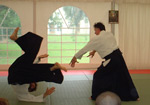 |
| This is usually done by throwing and control techniques that make up the main part of the Aikido techniques. The special feature in aikido is that no offensive attack techniques, but only defensive and assurance techniques and thus a correspondingly defensive and responsible stressed mindset be taught. |

Arnis
|
Arnis, Escrima, Kali stand for a mainly armed martial art of the Philippine area, which deals with different types of weapons, but also the unarmed combat. The art of Arnis was one of a number of arts and traditions of the Southeast Asian warrior caste Maharlika. As a martial art, it involved several aspects of the fight, where the emphasis was on armed conflicts. The difference between the traditional and modern art is that the classical Arnis is the original martial art, which deals with medieval instruments of war as swords and spears, and the modern Arnis tended to focus on the use of sticks and contemporary everyday objects. Modern Arnis grew only approach to art, as the Spanish colonial power in 1764 forbade its exercise and the population disarmed.
|
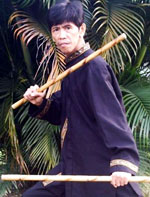 |
|

Capoeira
|
Capoeira is a Brazilian martial art and a combat dance whose origin on the African NíGolo ("Zebra Dance") is fed back. Capoeira was practiced during the colonial period in Brazil by embarked slaves from Africa and developed. Today, it is distinguished between two main directions: The "old" Capoeira Angola and the "modern" Capoeira Regional. Capoeira content marked by three levels: the fight, the music and the "Roda" (Portuguese "circle") as a social framework in which the fight takes place. The fighting techniques themselves are characterized by extreme flexibility; there are many rotational steps, jumped kicks and acrobatics. Traditional music is played at the fighting.
|
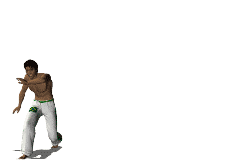 |
| The existence of Capoeira is proved since the 18th Century. The literature assumes that it originated in Brazil from a mixing of different African dances and cults. Capoeira is a martial art that is distinctly different from most other arts. The central element - the soul of Capoeira - is Malícia. Malícia can be described as "cunning, malice", but in the Brazilian it took a positive feature and can be interpreted more with "cunning" or "stratagem". Capoeira as a martial dance game based on a system of unwritten rules, which has been passed only by African oral tradition from generation to generation. |

Hapkido
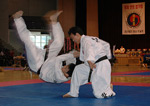 |
Hapkido is a Korean martial art that has its origins in the Japanese Daitō-ryū Aiki Jujutsu. Due to the influence of other fighting styles Hapkido evolved into an independent martial art that style is influenced across a comprehensive curriculum. Particularly characteristic are the numerous leverage techniques, which are together with throw, kick and punch techniques the main focus in all Hapkido styles. |
| Some styles teach in addition, the handling of different weapons. The movements in Hapkido are performed mainly circular and flowing. Hapkido is the most popular Korean martial art after Taekwondo and is trained worldwide. The word "Hapkido" is composed of the syllables Hap "unite" Ki "life energy" and Do "way, teaching". You can translate Hapkido e. g. as “The way of harmonious energy". The development of Hapkido took its beginning in the 1910s, when Korea was under Japanese rule. There are various Hapkido styles, which differ in their philosophy and techniques. In most styles the combative aspect of self-defense is considered important. There are also styles in which the interaction in the community is in the foreground. |

Jūdō
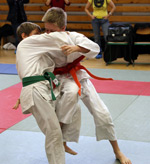 |
Jūdō is a Japanese martial art, whose principle is "winning by giving" or "maximum effect with minimum effort". Jūdō was justified by Kanō Jigorō (1860-1938), early 20th Century. He created a symbiosis of various ancient Ju-Jitsu styles. Judo is a way of physical exercise and in addition also a philosophy for personal development. Two basic philosophical principles are essentially based on Judo. First, the mutual help and understanding for mutual progress and well-being and on the other the best possible use of body and mind. (see also the Judo Kawaishi Systems) |
|

Karate
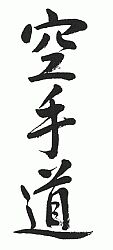 |
Karatedō (Japanese "way of the empty hand") used to be commonly referred to as karate and is performed under that name today most often. The addition of dō is used to emphasize the philosophical background of art and its importance as a way of life. Karate is aware of his Chinese roots, it is also regarded as descendants like the traditions of Chan, Bodhidharma and Shaolin. Karate is characterized by content of unarmed techniques, especially shock, impact, kick and block techniques and foot sweep techniques. This technique is the core category of karate training. The Japanese Karate is divided today into four major styles, namely Goju-Ryu, Shotokan, Shito-Ryu and Wado-Ryu. Many smaller newer styles based on one or more of these four schools. |
Kobudō
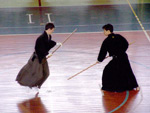 |
Kobudō refers to the martial art developed in Okinawa as farmer weapons, such as the Sai (a kind of trident), the nunchaku (short flail), the Bo (a 182 cm long rod), Kama (agricultural sickle), the tonfa (baton) or Tekko (brass knuckles). Especially in Germany, the Hanbo (90-100 cm long rod, half-bo) was established as another weapon, because this weapon is a good complement to Karate and Jiu-Jitsu-Training by Georg Stiebler. Further weapons were Timbei and Rochin (Shield of tortoise shells and short halberd), Wēku (paddle) or Suruchin (rope with weights at the ends). |
| The development of kobudo is attributed to the "working class" of Okinawa, but also the nobility and the officials. This is particularly evident in the origins of the kata because these have been developed by officials or nobles. The Okinawan Kobudo styles can be divided into several main directions which have been further split. Many of these styles are mixed well with each other again. |
Krav Maga
|
Krav Maga is an Israeli, modern, eclectic self-defense system that prefers punch and kick techniques, but also grip, locks and ground fighting involves. The name Krav Maga means "contact combat", where krav "battle" and Maga "contact" means. The origins of Krav Maga go back to the in 1910 born Imrich Lichtenfeld in Budapest. In the 1930s, Lichtenfeld taught for the first time his fighting method to support the with him living Jews against anti-Semitic attacks.
|
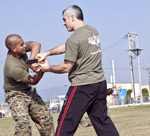 |
| Today Krav Maga is taught worldwide. Distinction must be made between three groups: private, secure area or the police and the military. Krav Maga is characterized by simple techniques. Natural and instinctive reactions are taken into account on the system and integrated with sense. As a result Krav Maga can be learned relatively quickly. Krav Maga is his own self-understanding not a sport but a pure self-defense system. There are no competitions. In particular, the right to react under stress is trained. |

Muay Thai
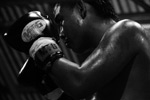 |
Muay Thai or Thai boxing is the national sport of Thailand. The Muay Thai evolved from regular martial arts. If sword and spear were unusable, the warrior used his legs, fists and elbows to fight. The classic, traditional style called Muay Thai Boran. |
| Muay Thai Boran is a very complex, traditional martial arts, which includes not only fighting with different weapons, but also movements that go far beyond the unarmed techniques of modern Muay Thai. Stylistically noticeable features of Muay Thai are the elbows, knees and clinching techniques. The most well-known technique for Muay Thai is the kick with the bare shin, usually on the thigh or rib area targeted. Due to the high risk of injury by elbow and knee techniques, Muay Thai is referred as one of the toughest martial arts in the world. Muay Thai throws are very dangerous, so most regulations prohibit it. |

Pencak Silat
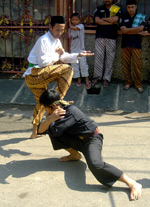 |
Pencak Silat is a martial art from Southeast Asia with a total of more than 800 individual styles. The center of Pencak Silat is Indonesia, here also has the PERSILAT, the World Association of Pencak Silat, their headquarters. The term Pencak Silat is a blend of the Javanese concept Pencak and the derived notion by Sumatran Silat. Both terms can be taken by itself translated as "martial arts". The origins of the Pencak Silat, as with many Southeast Asian martial arts, are largely unknown, only little has been written about them and the stories have always been transmitted orally from generation to generation. |
| Archaeological finds from the 6th Century AD testify to the fact that at that time already on the Malay Peninsula and Sumatra formalized combat systems were learned. Pencak Silat is often accompanied like many Southeast Asian martial arts by music. Here, each region has its own styles and instruments. In addition to the unarmed combat at Pencak Silat the practice with weapons has a high priority; therefore almost every style has its own repertoire of special weapons. In Pencak Silat there are competitions, in which, in full contact is being fought. Here protective clothing is worn. A fight goes 3 rounds of 2 minutes each. Kicks and punches are only allowed above the waist, head attacks are prohibited. There also be used throwing and holding techniques. Point ratings are there for hit, successful defending and throws. |

Sambo
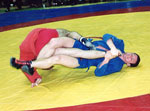 |
Sambo is a Russian Soviet combat sport. Sambo has its roots in Japanese judo / jiu-jitsu as well as in the traditional martial arts of Europe and the territory of the former Soviet Union. Sambo was developed from 1923 by the Soviet Army to improve their hand to hand combat. |
| Development objective was the merger of the most effective techniques of traditional martial arts to a format suitable for military training system. The term Sambo is composed of the Russian words Samooborona or oruschija ("Self-defense without weapons"). Sport Sambo is a competition with similar rules as in judo or Olympic freestyle wrestling. Permits are throws, fixation of the opponent on the ground and leverage of arms and legs. Strangling techniques are in contrast to judo banned. Combat Sambo resembles largely modern mixed martial arts competitions. Competitors wear protective headgear, mouth guard, groin guard, shin guards and light gloves. The rules have considerably more scope than those of the sport Sambo, they allow in addition throws, fixations and levers, also punches and kicks and strangling techniques. |

Tae-Kwon-Do
|
Taekwondo is a Korean martial arts. The three syllables of the name stand for foot technique (Tae), hand technique (Kwon) and way (Do). There it differs in some key respects from other Asian martial arts. Thus, taekwondo technique is very designed for speed and dynamics, which is not least due to the competition. In Taekwondo kicking techniques dominate clearly than in comparable martial arts.
|
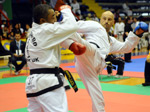 |
| The term Taekwondo first appeared in 1955 and was developed by General Choi Hong-Hi under the influence of Shotokan Karate. Taekwondo developed during the time when Korea was incorporated into the Japanese Empire (1910-1945). To achieve the necessary strength and the associated striking effect with a Taekwondo technique, the Taekwondoin operates with certain physical laws. Through continuous training and conscious exercise of these disciplines the Taekwondoin, trains his mind. General Choi Hong-Hi, the founder of the original Taekwondo has summarized this in five goals to be achieved, which are regarded as "principles of Taekwondo". |

Wǔshù
|
As Wǔshù all martial arts and combat sports are referred to, which originated from China. For many styles the term kung fu is used, which actually carries a wider meaning in Chinese, but by now in China it is the dominant term for Chinese martial arts. In China, there is a several hundred year old tradition of martial arts. Nowadays several hundred traditional and modern martial arts styles and systems are known.
|
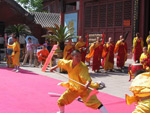 |
| The origin of most styles of the Martial Art of the Buddhist monks of the Shaolin Monastery or the martial arts of the Daoist monks from the Wudang Mountains. are often seen. In general, many styles not only serve or served self-defense or the applicability of the fight, but also meditation, fitness, or health care. Many martial art styles include both unarmed and armed techniques, with a wide variety of weapons are used. Initially, a student learns mainly the basics such as positions and movement principles of the martial arts style. Then a so called form, which is intended to internalize the basic techniques of the style as closely as possible. Only later the execution of the techniques is placed in the foreground. |

|